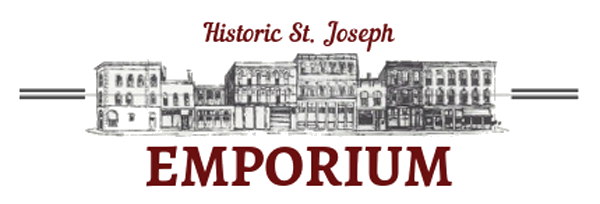Purchase Price $49,900
Side-by-side, 2 story duplex. 4 bd. each unit, 1,676 sq ft
Older duplex has been a good investment. With four bedrooms on each side, there is great potential to live on one side and rent out the other. Located in one of the most historic parts of the city; very close to the wonderful Mount Mora Cemetery and within easy walking distance of vibrant Frederick Avenue. Some work is needed, but this historic property is eligible for assistance such as the Save Our Heritage Grants from the City of St. Joseph.
Contact: Gregg Lowrance, United Country Property Solutions
Call: 816-232-7160
House History & Gallery
Built in around 1880, on what was then termed Cemetery Road (after the wonderfully evocative Mount Mora Cemetery, est. 1851, which is at the end of the road), the Ray Duplex at 717/19 Mount Mora Road is a wonderful window in to life in the growing city in the last half of the 19th century.
The substantial brick duplex was built by the Irish-born contractor and builder Richard Ray and his wife Julia. The family would live in one side and rent out the other as an investment property. This was a lovely place to raise their large family (in 1880 they had five children ranging in age from 19 to 6) and the rental unit provided a good living. Unfortunately, tragedy struck in September 1891 when Richard was driving his horse-drawn wagon full of his carpentry tools up Frederick Avenue. His horse was startled and bolted. After the horse had run nearly half a block, Richard decided that the horse was not going to stop any time soon jumped off the back of the wagon. He hit his head hard on the pavement. He died very early the next morning and was buried at Calvary cemetery (when that cemetery was closed he was moved to Mount Olivet).
Richard left his widow Julia with children to raise and a property to manage. She remained at the duplex until her death in 1913. Over the years various of her children and grand children lived in the duplex with her. Life was not altogether quiet for the Ray family. In August 1909 they were declared in contempt of court for failing to repay a loan of $5,000 that Julia had taken out from the county school fund for which she pledged the duplex as collateral. When she failed to repay the loan, attempts were made to foreclose on the mortgage. It seems that under this pressure, Julia found enough money to satisfy the creditors and she and her family remained in the home for another four years.
As with any rental, a fascinating variety of people passed through the doors of the other side of the duplex. Perhaps the most interesting was Edward F. and Ellen Fay Norton who lived there in 1910. Edward had been born in New York and he made his living as a vaudeville actor. His wife Ellen was a local woman. They married in the priests’ residence at Co-Cathedral after one of his matinees in July 1906 and he did the evening performance. Norton was a well-known and very popular figure on the theatrical circuit in St. Joseph.
Among the other early tenants were Harry Luchsinger, a part-owner of the Gleich & Luchisinger Saloon at 1701 Frederick Avenue; German-born Henry and Fred Kuhlman, brothers who were carpenters. Fred was a bit of a known character in the city, in May 19143 he had been arrested and sent to the workhouse for 30 days for public drunkenness after telling a patrolman that “he considered the position of dog catcher more dignified than that of a copper.”
In 1920, Elmer G. and Maud Minnis moved in to 717 and their family remained there into the mid-1940s. Elmer was a truck driver who over the years worked for various local companies including Western Tablet Company and Stuppy Floral. His wife Maud was a dressmaker who worked out of the house. Earl died in 1930, but Maud continued to rent her side of the duplex. Their son Earl Jr. lived with his mother periodically. He had only completed one year of high school and was working as a taxi-driver before the outbreak of WWII. He was living there when he registered for the draft in 1940 and he served in the military until 1945 when he returned to St. Joseph and moved back in with his mother, who died shortly afterward. Not long after his mother’s death in 1945, Earl Jr. moved to Los Angeles.
In the early 1930s, the Reverend Samuel H Taylor and his wife Alice lived in 719. The Rev. Taylor was from England and worked as the pastor of Oak Grove Presbyterian Church. Their son James R. Taylor, worked for a time as a public school teacher before going to graduate school at the University of Michigan. Alice, their daughter, was a stenographer for the Masonic Temple. In 1932, the family moved to Michigan where he owned some property.
Over the long life of this duplex working people associated with the various industries that were the economic backbone of the city lived here. They were saloon keepers, seamstresses, truck drivers, barbers, packers, teachers, and preachers. Truly the Ray Duplex has seen the whole panorama of St. Joseph history pass through its doors.




